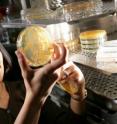WPI researchers take aim at hard-to-treat fungal infections
A team of researchers at the Worcester Polytechnic Institute (WPI) Life Sciences and Bioengineering Center at Gateway Park has developed a new model system to study fungal infections. The system can be a powerful tool for screening potential drug targets for conditions like thrush, athlete's foot and vaginal yeast infections, which affect millions of people each year but are difficult to treat with existing medications. Using the new model, the researchers also identified a gene that may be a promising target for a new anti-fungal drug. The WPI research team led by Reeta Prusty Rao, PhD, assistant professor of biology and biotechnology, developed the new model using the microscopic soil worm Ceanorhaditis elegans (C. elegans) as a test host which is then infected with the fungus Saccharomyces cerevisiae (S. cerevisiae). Commonly known as baker's yeast or brewer's yeast, S. cerevisae doesn't cause disease in humans, but the WPI team found that it can infect, and if left untreated, kill the worm. Since S.cerveisiae has many genes in common with fungi that do cause human disease, the genetic and molecular analysis now possible with this new testing model can be used to identify targets that could prevent or treat fungal infections in people.
"The beauty of this new model is that we can study both sides of the equation: the processes of fungal infection and the host's response to try and fight off that infection," said Prusty Rao.
Fungal infections are persistent and are not easily cleared by the handful of drugs currently available to treat them. As a result, the infections often reoccur. Typically, common fungal infections like athlete's foot and vaginal yeast infections do not cause serious harm. However, when an infection spreads to the bloodstream, it can be deadly. Hospitalized patients with catheters or central intravenous lines are at risk, as the fungi can grow on those devices and enter the body. Because of the lack of an effective treatment, the mortality rate for some systemic fungal infections is nearly 45 percent.
In their recently published study, Prusty Rao's team, working in collaboration with Samuel Politz, PhD, associate professor of biology and biotechnology at WPI, used a range of available genetic tools to monitor the infection process and observe how the worm tried to defend itself against the infection. They also studied which genes in the yeast were involved in trying to fight back against the worm's defense mechanisms. The team reported their findings in the paper "A Pathogenesis Assay Using Saccharomyces cerevisiae and Caenorhabditis elegans Reveals Novel Roles for Yeast AP-1, Yap1, and Host Dual Oxidase BLI-3 in Fungal Pathogenesis" published by the journal Eukaryotic Cell.
The work showed that the worms produce hydrogen peroxide and other so-called reactive oxygen species (ROS) to try and kill the invading fungus, while certain genes in the yeast produce other chemicals that can ward off the hydrogen peroxide attack. One gene in particular, called Yap 1, was found to be essential for the yeast's ability to neutralize the ROS attack. When they removed Yap 1 from the yeast's genome, infection was prevented. This was an important finding because Yap 1 is found only in fungi, not people. If a drug can be developed to target only that gene, it should not have any side-effects in people.
"The challenge has been to find therapeutic agents that can kill the fungus, but not harm the surrounding tissue; that's proven to be very difficult," Prusty Rao said. "In this study, we show that the gene Yap 1 is essential for infection, and it is only found in yeast, including the strains that do cause disease in people. So this is a promising target for further study."
Source: Worcester Polytechnic Institute
Other sources
- WPI researchers take aim at hard-to-treat fungal infectionsfrom Science BlogThu, 19 Nov 2009, 17:49:48 UTC
- Taking aim at hard-to-treat fungal infectionsfrom Science DailyThu, 19 Nov 2009, 17:35:29 UTC
- Researchers take aim at hard-to-treat fungal infectionsfrom PhysorgThu, 19 Nov 2009, 16:35:36 UTC
